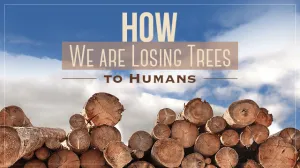Have you ever wondered how many trees there are on the entire planet? No? Well, we’ll tell you anyway. In a recent inventory, researchers counted a whopping 3.04 trillion trees. They were able to do so using satellite images, forest inventories and amazing computer technology, as well as historic forest covers to come up with this number.
At first glance, you might think, 3.04 trillion trees is huge, and we really have nothing to worry about, but you’d be wrong. This inventory also reveals, that since the beginning of civilization we have lost almost 50 percent of our tree population, and given the importance of trees for our survival, this is a pretty scary thought.
Considering the fact that the agricultural revolution only started around 10,000 years ago, it is safe to say that the majority of our trees have disappeared in this relatively short amount of time. Deforestation happens at an increasingly rapid pace, so we can assume that we will lose a lot more trees in the coming centuries and millennia, unless of course we start doing something about it.
Read: Destruction of the Amazon Rainforest Could Lead to Droughts in Western U.S.
What makes trees so important to us? During a process called photosynthesis, trees store carbon dioxide and release oxygen into the air. By storing massive amounts of carbon dioxide, trees are absolutely essential to our air and water quality. Of course, trees also provide shelter and nutrition to animals, and in turn to us humans. It is a life cycle we have only just begun to comprehend.
Andrew Steer, CEO of the World Resources Institute, said, “Half a billion people depend on forests for their jobs, their food, their clean water. More than half of all terrestrial biodiversity lives in forests.”
Article: Time Spent Outdoors Is Good For Your Emotional Well-Being
Unfortunately, every day forested areas roughly the size of 50 soccer fields fall victim to deforestation by humans. And this number only takes into account the past 13 years. It’s a sobering and disheartening fact, and it drives home the importance for change.

The website has revealed sobering data, including the almost complete deforestation of the protected Marahoué National Park in Africa’s Ivory Coast, with nearly 90 percent already destroyed. It is certainly a wake-up call, and may be just what we need to initiate the change we want to see. Check out Greenpeace for the article Solutions to Deforestation.
-Ute Mitchell
Ute Mitchell is a Freelance Writer and Nutritional Therapy Practitioner located in Portland, OR, where she homeschools her kids, cooks healthy meals for her family, and hikes the forests and mountains around the Pacific Northwest. She is an avid CrossFit athlete, and loves to encourage others to live a healthy and active lifestyle.
Sources:
http://www.mnn.com/earth-matters/wilderness-resources/stories/how-earth-lost-half-its-trees-to-humans
http://www.livescience.com/43527-deforestation-map-online.html
http://www.greenpeace.org/usa/forests/solutions-to-deforestation/
